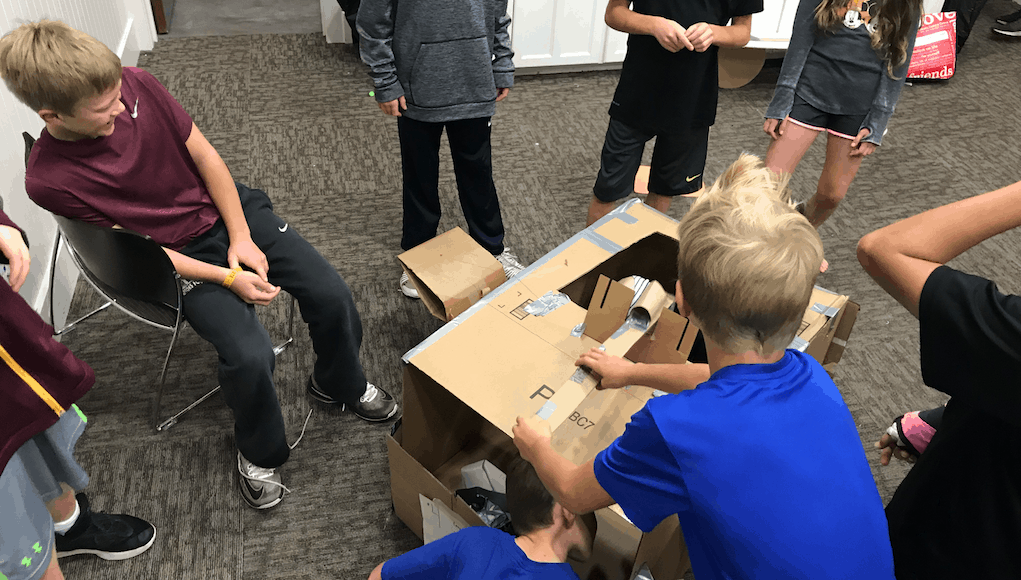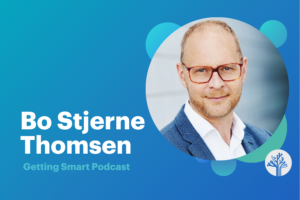Getting Creative with Cardboard: The Perfect Mix of Learning and Fun

Sometimes (okay, a lot of times), I over complicate my role as a parent — especially when it comes to promoting powerful learning. Parenting can feel daunting, and it is way too easy to get caught up in the pressure of doing “all the right things” to set forth the ideal learning path for our kids.
However, one of the most important lessons I’ve learned over my 19 years as a parent is to keep it simple and to look for easy ways to tie together learning and fun. When we focus on creating positive environments where learning and fun go together, it reduces the pressure and increases the joy.
One of my favorite examples of a time when we created a simple plan for learning and fun was participating in the Imagination Foundation’s Day of Play through a Cardboard Challenge.
When our ten-year-old and I saw a tweet about the Cardboard Challenge, we decided to host an event. He promised to help. I promised myself that I would keep it simple. No fancy birthday-party-like prep; just a quick e-vite, a list of things other parents could do to help out, some recycled cardboard and a free facility in which to make.
I am sharing this experience in part so it could be easily replicated for those who wish to — but even moreso because of the mindset it forced/allowed me to have as a parent.
About the Cardboard Challenge
There’s something about recycled cardboard and duct tape that just says “keep it simple.” While we did it on the “official day of play,” this is a simple and purposeful even that could happen anytime.
The idea behind the Cardboard Challenge is that kids of all ages from around the world come together to build something amazing out of cardboard, recycled materials and imagination (see this interview with Mike McGalliard, Founding Director of the Imagination Foundation for a little more backstory).
Inspired by the short film, Caine’s Arcade, the Global Cardboard Challenge is an annual event presented by the Imagination Foundation to celebrate child creativity and the role communities can play in fostering it. It recognizes the value of creativity, one of the most critical skills of the future.
A Simple Yet Purposeful Approach to a Day of Making
For our event, we took a few basic steps leading up to the big day:
- Selected a date. We made sure there were no competing athletic events, practices, etc
- Reserved space. We found a free space in our community (but it would have been just as easy to do in our backyard or basement).
- Sent out an invite. We asked people to bring recycled cardboard, tape, and snacks.
- Saved supplies. We saved cardboard ranging from boxes to paper towel tubes and more.
- Gave a few instructions. The instructions were based on a simple formula; we paired up the kids up to work and told them we would vote on the best overall creation (and there were a few prizes).
Tape + Cardboard + Imagination = ????
When asked what they liked best, the kids said:
- I could build anything I wanted,…no rules!
- I loved that there were no “wrongs” or “rights”
- There were fun supplies to work with
- I loved working with a partner
- No rules!
- I had fun and liked playing with my friends!
- I liked using creativity and my imagination to build whatever I wanted while having fun with my friends.
- Yum! I liked the pizza and brownies.

As for the parents, here’s what they observed
- I loved that the kids were doing something tactile that didn’t involve electronics!
- Seeing the boys being creative, putting together a plan and executing in a short amount of time was awesome.
- I loved seeing the creativity, salesmanship, and building something with their hands…and no electronics were involved!!!
- I liked fun without technology.
- Hanging out with the parents while the kids were occupied was fun.
- It was great to see the boys use their imagination and not even think about electronics!
Loved participating in @imagination Foundation’s #CardboardChallenge and Day of Play @Getting_Smart pic.twitter.com/W5pEr3Symr
— Mary Ryerse (@maryryerse) October 9, 2017
Additional Tips for Teachers or Parents Who Want to Go Deeper
Many schools use the Cardboard Challenge as a way to incorporate design thinking, project-based learning and maker strategies in the classroom. Whether you’re pursuing this as a parent or a teacher, here are a few more tips as you get started.
- Get the kids excited by showing the Caine’s Arcade video ahead of time.
- Show the kids what other kids have done. Simply look up #cardboardchallenge for ideas.
- Sign up to be part of the movement at cardboardchallenge.com so that everyone can see the reach of the project.
- Backwards plan from your event date, and modify plans to fit your goals (ours was for fun and creativity; some teachers and schools use it as a way to infuse design thinking).
- Decide on your purpose before execution. Will it be purely creative? Will it be theme-based? Will it be based in design thinking? Will it be PBL?
- Have fun! It should be fun for kids AND adults.
- Share your #CardboardChallenge experiences with the world so that kids should have a platform for their #creativity and feel proud.
- Embrace the chaos of #creativity!
To underscore my point, this was a simple way as a parent to integrate learning, fun and a sense of community. Will you consider joining the cardboard movement?
Or, consider one of another zillion ways parents can tie together learning and fun in simple ways — try geocaching, take a trip to a museum, play a game, head to the library, go on a leaf hunt, create a fun space to learn, go to a free concert, make something together in the kitchen, teach your child something you love to do… and so on!
For More, see:
Stay in-the-know with all things EdTech and innovations in learning by signing up to receive the weekly Smart Update.





0 Comments
Leave a Comment
Your email address will not be published. All fields are required.